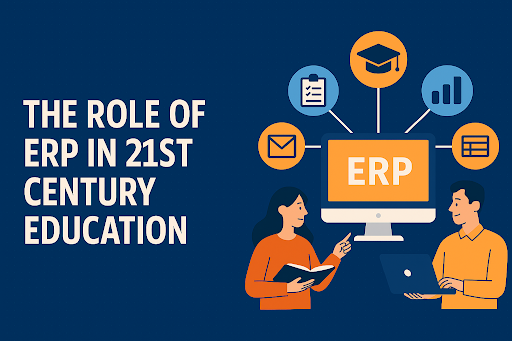Education in the 21st century is no longer confined to classrooms, chalkboards, and printed timetables. Today, learning environments are hybrid, student expectations are higher, and institutions are expected to be not only academic spaces but also centers of digital efficiency.
To meet these demands, schools, colleges, and universities must embrace technology—not just in teaching, but in management too. That’s where Educational ERP (Enterprise Resource Planning) steps in as a transformational tool that connects every aspect of an institution into one intelligent system. erp for colleges is very important in this 21st century.
Best ERP Software For Colleges
In this blog, we’ll explore how ERP is shaping 21st-century education, the key benefits it brings, and why institutions that don’t adopt it risk falling behind.
🎯 Who Should Read This?
If you’re a:
- 🎓 College Administrator looking to reduce manual work
- 💼 Trustee or Owner focused on institutional growth and ROI
- 👨💻 IT Head wanting to modernize infrastructure
- 👩🏫 Faculty or Principal seeking academic efficiency
- 📊 Educational Consultant guiding digital transformation
Then this article will show you why ERP is the backbone of modern education management.
🏫 What is Educational ERP?
An Educational ERP is an all-in-one software platform that integrates every department in an educational institution—from admissions and academics to finance, library, transport, hostel, and HR—into a single centralized system.
It enables automation, real-time data access, and better collaboration across all stakeholders: students, staff, faculty, parents, and administrators.
Think of it as the digital nervous system of a modern institution.
🔍 Why 21st Century Institutions Need ERP Now More Than Ever
Let’s face it: today’s educational landscape has evolved rapidly. Here are some of the real-world challenges colleges and universities face today:
| Challenge | Traditional Way | ERP Solution |
| Managing admissions | Manual forms, offline follow-up | Online forms, real-time tracking |
| Attendance tracking | Paper registers | Biometric or mobile app tracking |
| Exam & grading | Delayed results, errors | Instant result publishing |
| Fee collection | Long queues, errors | Auto-reminders & payment gateways |
| Communication | Disconnected, manual | Real-time SMS, email, and portal updates |
Institutions need to be faster, more transparent, and data-driven. ERP enables exactly that.
💡 1. Centralized Academic & Administrative Control
In most institutions, departments run on disconnected tools or spreadsheets. This causes data duplication, errors, and delays in decision-making.
With ERP:
- All information is stored in a single database.
- Admins can manage admissions, attendance, staff, exams, and fees from one dashboard.
- Students and parents access their profiles, updates, and records via a mobile app or web portal.
Tired of syncing multiple tools and chasing updates? ERP ends data silos.
📈 2. Data-Driven Decision Making
21st-century leaders don’t make decisions on gut feeling—they rely on real-time insights.
ERP provides:
- Admission analytics
- Academic performance dashboards
- Fee collection trends
- Faculty workload tracking
- Resource usage (labs, library, hostels)
Want to make smarter growth plans? ERP gives the numbers that guide them.
🧠 3. Enhanced Teaching & Learning Environment
Faculty members are often overloaded with non-teaching tasks—attendance, grades, timetables, internal assessments.
ERP automates these functions, allowing teachers to:
- Focus more on student engagement
- Share assignments and notes digitally
- Schedule and track classes effortlessly
- Communicate with students/parents in real-time
Want to spend more time teaching and less on admin? ERP handles the busywork.
🤝 4. Seamless Communication & Collaboration
In a digital-first world, instant communication is expected. Students and parents want quick updates on academic performance, fees, holidays, and events.
ERP ensures:
- Students get alerts for classes, exams, and results
- Parents receive fee reminders and attendance reports
- Faculty and admin can send circulars with one click
Want fewer complaints and more clarity? ERP bridges the communication gap.
💳 5. Smarter Financial Management
Managing finances manually leads to miscalculations, fraud risks, and lack of transparency.
ERP allows:
- Online fee payments and auto-generated receipts
- Customizable fee structures, discounts, and fines
- Staff payroll automation with TDS and PF
- Budgeting and expenditure tracking with audit reports
Tired of paper trails and missing receipts? ERP brings clarity and compliance.
🔐 6. Compliance & Accreditation Made Simple
From NAAC to UGC and AICTE, institutions need to submit periodic reports and stay compliant.
With ERP:
- Reports are generated automatically
- All student/staff data is centrally stored and exportable
- No last-minute data collection chaos
Struggling with last-minute compliance reports? ERP makes accreditation stress-free.
📲 7. Mobile, Cloud & Future-Ready
Modern ERP systems are built for flexibility:
- Access ERP anywhere via mobile or cloud
- Integrate with biometric systems, LMS, or even AI tools
- Regular updates keep your institution future-ready
Want to stay ahead of the curve? ERP is your gateway to EdTech transformation.
🏆 Real Impact: What Educational Institutions Say
- 🔹 “Our fee collection accuracy improved by 98% after ERP adoption.”
- 🔹 “We save over 150+ staff hours every month.”
- 🔹 “Exam results are now declared within 24 hours.”
- 🔹 “Parents are more satisfied due to instant communication.”
Whether you’re a small private college or a multi-campus university, ERP helps scale operations and improve quality across the board.
✅ Final Thoughts: ERP is the Heartbeat of Modern Education
In the 21st century, adopting ERP is no longer a choice—it’s a necessity.
It connects your departments, empowers your staff, informs your leadership, and engages your students. More importantly, it positions your institution as tech-savvy, future-ready, and student-first.
If you’re still relying on spreadsheets, isolated software, or paper registers, now is the time to consider a switch. Your competitors already have.
